Purple Vegetables – Includes Photos & Cooking Tips
Purple vegetables are fun because of their eye catching color, plus they add extra nutrition to meals. Eating the rainbow is more fun when you grow it yourself.
Before you go all in with “purple” in your garden, there are a few things you should know. Those bright pigments can do strange things when you start cooking. I’m sharing some of our favorite varieties of purple veggies, plus cooking tips, and health benefits.
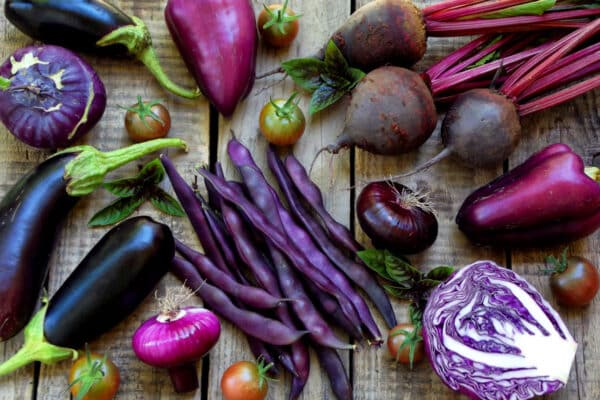
Purple Vegetables for Your Garden and Table
I love experimenting with with different varieties of fruits and vegetables our garden. Each variety has a unique flavor, and it’s fun to see the range of colors and textures. Our purple crops run the range from near indigo to plum.
In addition to adding color, you may find purple vegetables less bothers by pests than their standard counterparts. This is most common for leafy vegetables, like lettuce and kale. This makes your garden more resilient as well as beautiful.

Purple Beans
We grow purple podded pole beans every year. They are prolific and easy to harvest, because the beans show up well against the green foliage. (They are much easier to spot than green beans, which blend with the leaves and stems.) You can also grow purple bush beans, such as Purple Queen, and yard long beans, such as purple Mart Tsu.
These beans turn green when cooked, because heat breaks down anthocyanin. Heat also breaks down the cells of the beans, diluting the acidity of the cell sap. (There’s no color change when they’re eaten raw.)
Soaking the beans in vinegar or lemon juice before cooking boosts the acidity, slowing down color loss. Minimizing cooking time with steaming or quick cooking in addition to soaking may preserve some of the color. You can also plunge the beans into ice water to stop cooking and help reduce color loss.
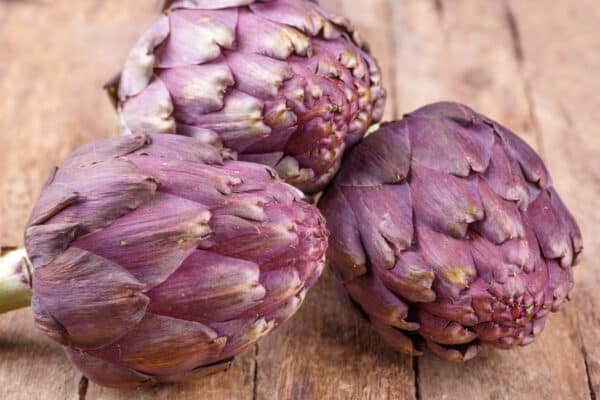
Purple Artichoke
Artichokes are a perennial in zones 8-11, but are a challenge here in our northern garden. A local friend has grown them, but I haven’t tried it yet. For those in warmer climates, check out Purple Romagna artichoke.
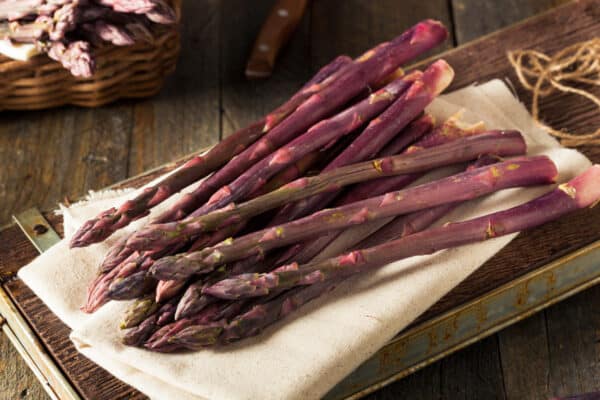
Purple Asparagus
Purple asparagus has a slightly sweeter taste than green asparagus. Ours tends to pop up a little earlier in the spring, too. My favorite way to enjoy it is roasted asparagus.

Beets
Try roasting beets to bring out the natural sweetness in this root vegetable. We also enjoy them pickled and sauteed.
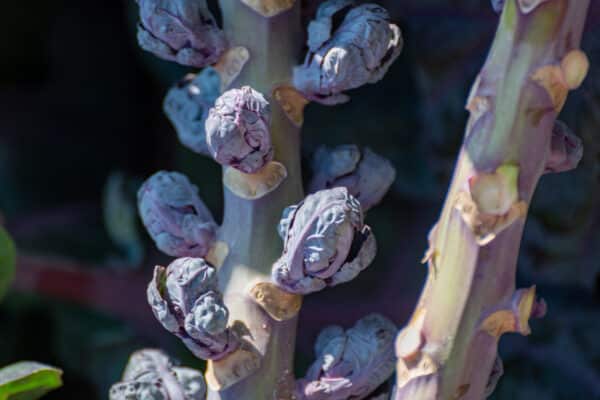
Purple Brussels Sprouts
For a miniature burst of purple goodness, consider growing purple Brussels sprouts. These compact, cabbage-like vegetables offer a milder flavor than their green counterparts. Packed with vitamins and fiber, purple Brussels sprouts are a nutritious addition to your garden and your dinner plate.

Purple Cabbage
Red cabbage turns a lovely deep purple color after cooking. Adding acid will shift the color brighter. (Fermenting turns it hot pink from the acidity.) Roasting and sauteing bring out the sweetness of the cabbage.
So far my favorite variety is Red Kalibos cabbage, which grows in an interesting pointed head. It tolerates heavy rains without splitting. Purple Savoy cabbage has lovely ruffled leaves, and Red Acre is a reliable producer.

Purple Cauliflower
Purple cauliflower looks like big purple pompoms hiding in the brassica patch. Di Sicilia Violetta is a purple heirloom variety that grows well in our northeast Wisconsin garden. Graffiti hybrid is an option that does well in humid climates. These turn light green when cooked.
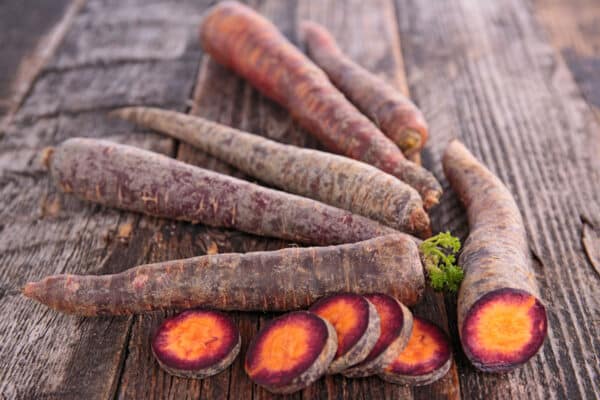
Purple Carrots
While orange carrots are the norm, you can also grow purple, red, yellow or white varieties. Some types, like Purple Haze and Cosmic Purple, have a purple outer ring with orange interior.

Black Nebula is the darkest carrot we’ve ever grown. A deep purple throughout, it’s so dark that it can be used for dying. Just one carrot can completely change the color of a recipe. I’d suggest that families with picky eaters use these with caution.

Purple carrots do tend to have a firmer texture, so we generally serve them cooked. Roasting helps to preserve the color. Cooking also makes the nutrients more bioavailable.

Purple Corn
Both sweet corn and flint corn exist in purple-red colors. Soltera Morado sweet corn from Siskayou Seeds has such intense color that it is used for dying.
Dakota Black popcorn is a deep burgundy color. Miniature Blue popcorn is heat and drought tolerant. Hopi Purple corn is a flour corn with purple to violet rose colored cobs. It is also heat and drought tolerant.

Eggplant
Eggplant is one of the most familiar purple vegetables. That beautiful color is only skin deep, so you’ll need to keep the skin on to retain those nutrients. Make sure to harvest your fruit when the seeds are small and immature, and use it promptly after picking. Eggplant is not a good vegetable to leave rolling around in the refrigerator.
Roasting and sauteing are some of the most popular ways to cook eggplant. We prefer the slim Asian varieties, which tend to produce an abundance of smaller fruits. Look for Italian varieties like Black Beauty for larger fruits.

Purple Kale
Kale is a nutritional powerhouse, and the purple variety adds a vibrant touch to your garden. Rich in vitamins A, C, and K, as well as antioxidants, purple kale is a versatile leafy green. Use it in salads, smoothies, or as a nutritious sautéed or steamed side dish.
Red Russian has dark purple-red veining, and Red kale has deep red color throughout the leaves. Ornamental kale looks like a giant flower, but the leaves are also edible.

Would you like to save this?
Purple Amaranth
Purple amaranth is related to wild pigweed. The young greens make a good cooked vegetable, and the seed is a gluten free protein source.
We grow Joseph’s Coat amaranth, which has purple veining. Other red/purple varieties include Red Spike, Red Garnet, or simply Purple Amaranth. Use the plant similarly to kale.
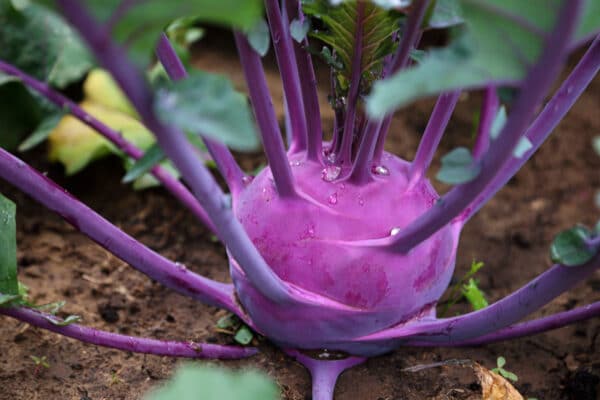
Purple Kohlrabi
Heirloom Purple Vienna kohlrabi is a reliable producer in our garden. It grows about 2-3′ across and has white flesh. Enjoy it cooked or raw for a good source of vitamin C.

Purple Lettuce
Purple lettuce and other leafy vegetables served fresh are a great way to retain that purple color on your plate. Tear or chop the leaves and serve with a light vinaigrette to improve digestion.

Red Onions
Red onions have reddish-purple skin and some purple tint to the flesh. They add a pop of color to fresh salads, like this cucumber onion salad. You can also use them in other dishes just as you would use yellow or white onions.
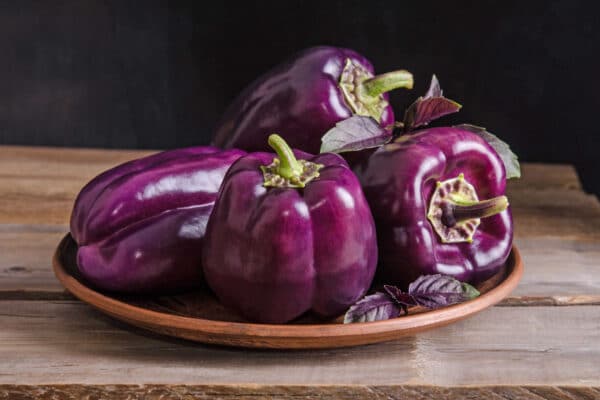
Purple Peppers
Both sweet and hot peppers come in purple varieties. Purple Beauty is a reliable producer in our garden, but I’ve been thinking of trying Lilac Bell.
Purple Tiger hot pepper is so pretty it looks like a Christmas ornament. Cayenne Purple is slightly sweeter than traditional red cayenne pepper.

Purple Potatoes
Our favorite purple colored potato is Purple Majesty, which produces an abundant midseason crop of mid-sized tubers. The texture is firm and moist, not waxy or dry. We also grow Adirondack Blue potatoes, which produce a large potato that’s great for baking.
Both of these potatoes have purple skin and purple flesh, and keep fairly well in the root cellar. For best color retention, bake or fry. Boiling washes out the color – the longer you boil the more grey the potatoes get.
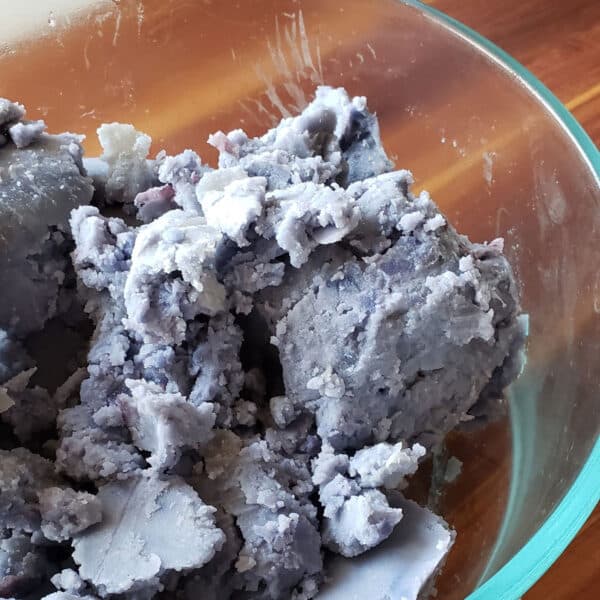
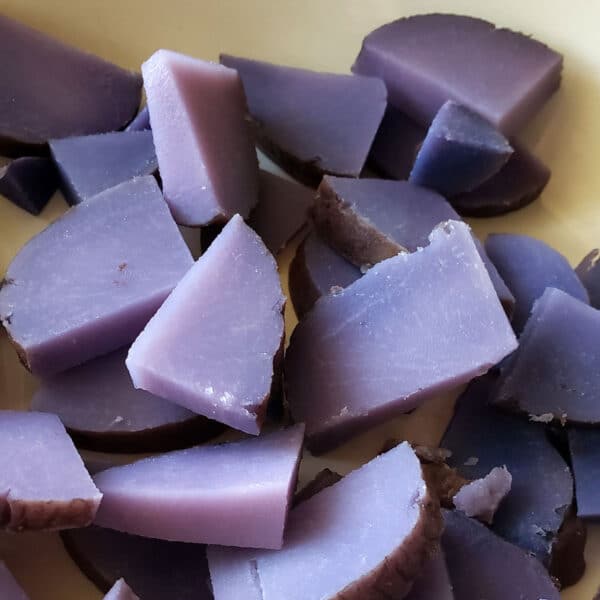
The darkest purple potato I’ve grown is Purple Peruvian, which is an heirloom fingerling potato. They are crazy dark, and look like small purple rocks or odd scat. We found the texture to be extremely dry, but I may try them again at some point.

Purple Radish
Purple Plum radishes are my favorite radish variety. I’ve tried many different types over the years, but these always have a place in my garden. They tend to resist bolting better than other varieties, and stay mild longer.
You can also find purple radish microgreen seeds. These are great for adding a pop of color to salads. I prefer eating radish fresh or in cold salads.

Purple Sweet Potatoes
Purple sweet potatoes are gorgeous, with eye catching purple flesh. They like warmer weather than we have here in Wisconsin, so I have not attempted to grow them.
Stokes Purple sweet potatoes were developed in Stokes County, North Carolina. They have light purple skin, deep purple flesh, and a mildly sweet taste. Molokai Purple Sweet Potatoes are another deep purple variety, developed in Molokai, Hawaii.

Purple Tomatoes
Most “purple” tomato varieties have blue or purple skin and a red interior. Sometimes the color carries into the flesh, as with Black Krim tomatoes. Cherokee Purple tomato is a popular heirloom variety.
Chocolate cherry is our favorite small fruited purple tomato. It’s wonderfully sweet with a unique flavor. Indigo apple is a nice slicing tomato, with striking deep purple skin.
The tomato relative, tomatillos, are also available with purple skin. Use them to make tomatillo salsa (salsa verde).

Purple Turnips
Turnips are another cabbage family root vegetable. Purple Top White globe turnips have edible leaves and roots, and are ready to harvest in 50-60 days. Harvest fall crops after a light frost for best flavor.
Try roasting turnips to bring out the sweetness in the roots. Saute turnip greens for a hearty side dish.
Health Benefits of Purple Vegetables
Purple vegetables contain various antioxidants, such as anthocyanins, flavonoids, and polyphenols, which help combat oxidative stress in the body. These antioxidants scavenge free radicals, reducing the risk of chronic diseases like cancer, cardiovascular disease, and neurodegenerative disorders.
Anthocyanins have been linked to improved heart health by reducing inflammation, lowering blood pressure, and improving blood vessel function. Regular consumption of purple vegetables may contribute to a healthier cardiovascular system and lower the risk of heart disease.
Some studies suggest that antioxidants may help protect brain cells from damage and support cognitive function. Consuming foods rich in anthocyanins may help improve memory, concentration, and overall brain health.
Purple vegetables contain compounds that possess anti-inflammatory properties, which can help alleviate inflammation throughout the body. Chronic inflammation is linked to various health issues, including arthritis, diabetes, and autoimmune disorders. Including purple vegetables in your diet may help mitigate inflammation and promote overall wellness.
See “Anthocyanins in Chronic Diseases: The Power of Purple“.
Purple carrots contain compounds like beta-carotene and lutein, which are beneficial for eye health. These compounds support vision, protect against age-related macular degeneration, and reduce the risk of cataracts.


This article is written by Laurie Neverman. Laurie and her family have 35 acres in northeast Wisconsin. They grow dozens of varieties of fruiting trees, shrubs, brambles, and vines, along with an extensive annual garden. Along with her passion for growing nutrient dense food, she also enjoys ancient history, adorable ducks, and lifelong learning.

wow, I never realized there were so many varieties! Thanks so much for sharing!
Thank you for the informative article. I have a few purple items slated for our spring and fall garden, but now I have a few new ideas. I look forward to reading each article I receive, there is always a wealth of knowledge. Many thanks,
Angel Sprayberry
Dragon Tongue green beans are green with purple while growing. The purple does fade with cooking. One of the tastiest beans I’ve come across!
A local friend of mine grows those and loves them, too.
Hi Laurie,
I enjoyed your article on purple veggies. A couple years ago I walked through a community garden at The University of Michigan, Dearborn campus, and someone there was growing fuscia purple Chinese style peapods. They were beautiful and I thought how cool it would be to make a stir fry and add a few of these at the end so they would add a bright color to a chicken and vegetable stir fry. I am not sure who sells these seeds.
I was thinking as I was wrapping up that I forgot to add blue podded peas, but the list was already pretty long. We grew Sugar Magnolia Snap Pea last year, which is available from Pinetree Garden Seeds. They also carry a Blue Podded Pea that can be used as a snow pea or dried pea. True Leaf Market carries a pea they call Blue Shelling, which looks similar to Pinetree’s Blue Podded. Lots of different options available now.